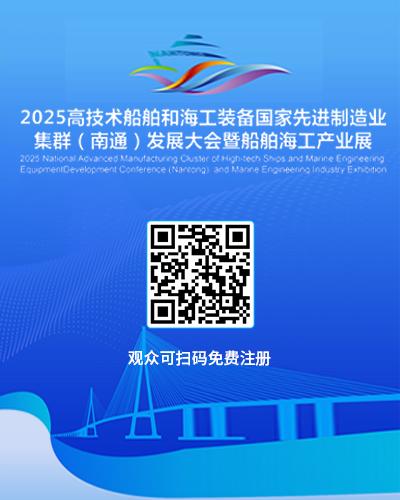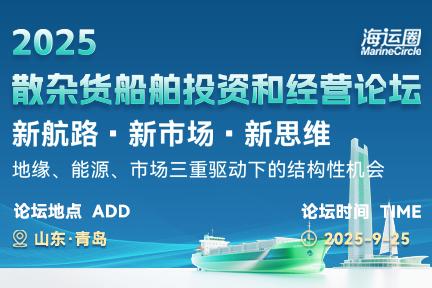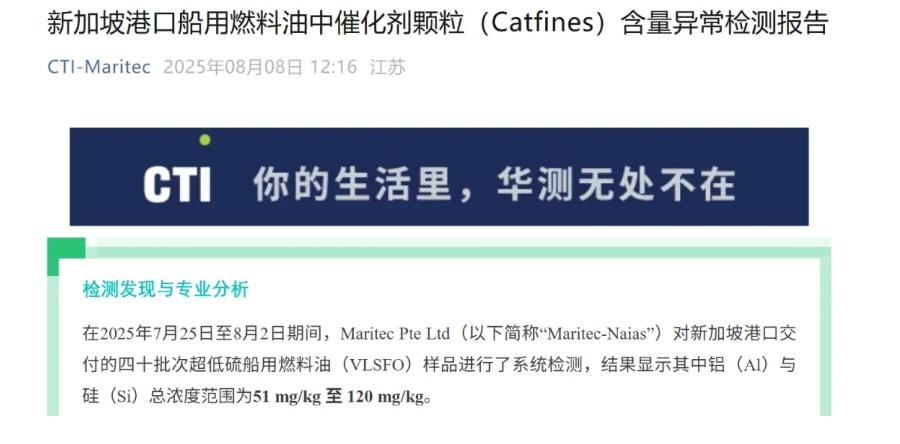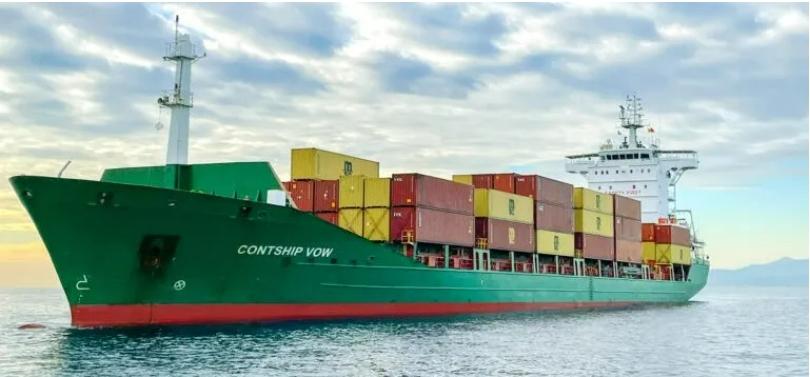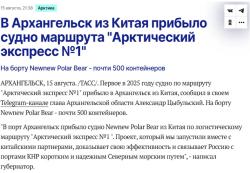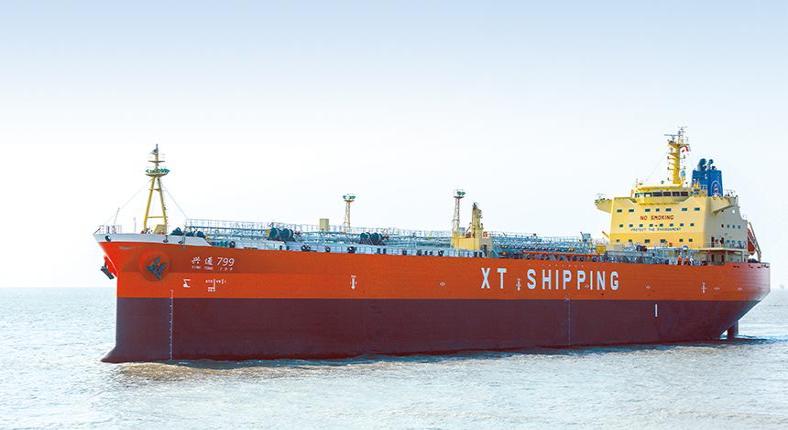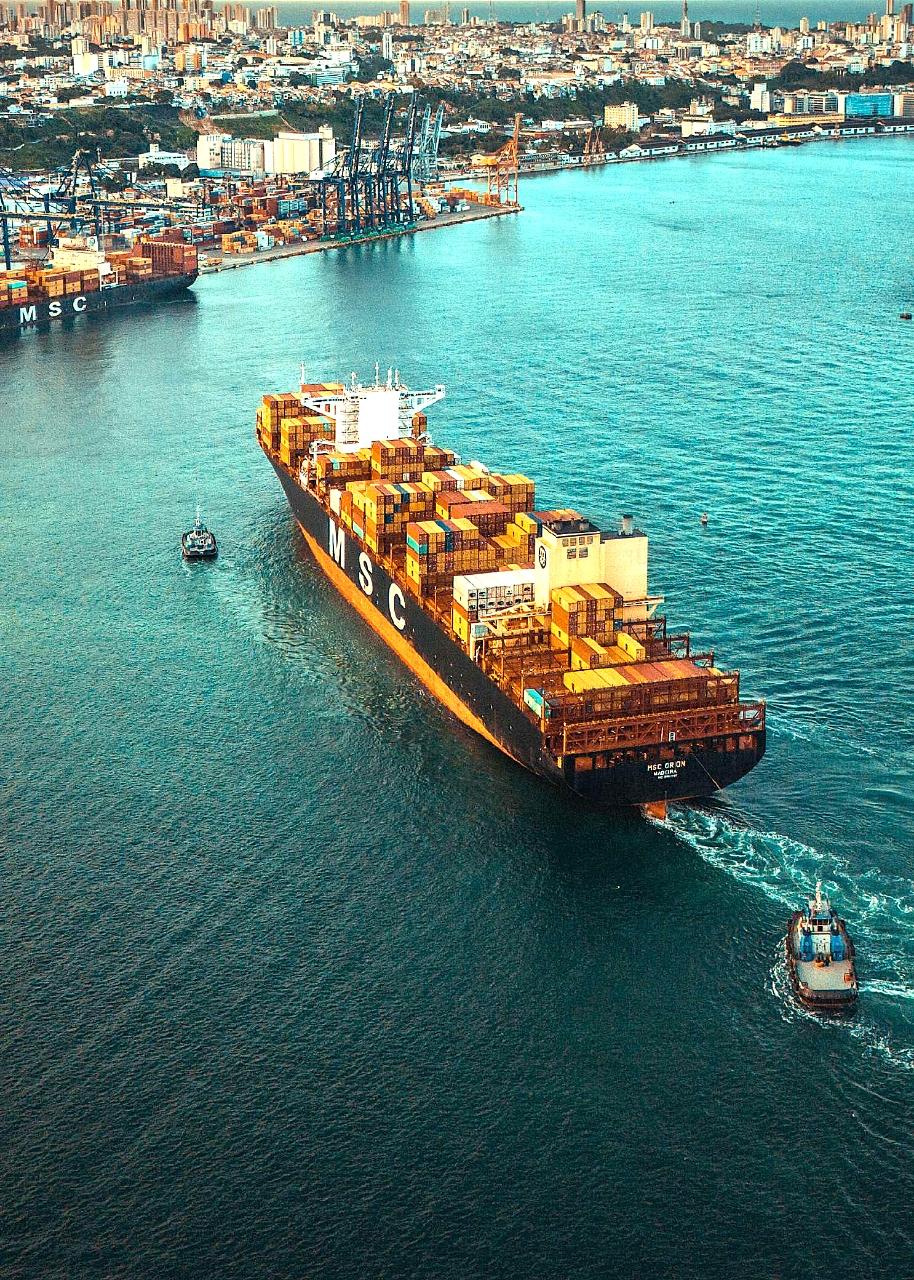By a charter-party dated 7th/Sep 2018 the Owners let their vessel U to m/s R in Singapore. as charterers for the carriage of a cargo of grain production from Lubuk Gaung, Indonesia to one or two Chinese ports. The charter which was on the Gencon 94 form provided inter alia:
Vessel’s particular
MV U
DWT 8600 DWCC 8000MT ON 8.5M TWEEN DECK(single used for mid decks were take out )
BELIZE FLG,BULT DEC 1994,ICS CLASS,
LOA/BREADTH 98.17/18.8M GRT/NRT 5552/3077 2H/2H G/B 13790CBM/12634CBM.
4*15MT DERRICKS MAC GREGOR FULL FOLDING TRYPE-UPPER DECK,PHONTOON TYPE-LOWER DECK.
SPEED 10.5KNOT,P&I/IMSBC COVERED ADA.
1- LCAN :16 - 21 SEP 2018
2-Cargo-6,000 MTS 5% MOLOO BULK AGRIPRODS A/O IT'S BY PRODUCTS
3a-LDG 1/2 SB/A(S) 1SP LUBUK GAUNG,INDONESIA
-OWNRS TO SATISFY THEMSELVES WITH DRAFT RESTRICTIONS IF ANY BENDS
3b-OWS/MASTER TO GIVE DEFINITE 7/5/3/2/1 DAYS ETA NOTICE LOAD/DISCH PORT FAILING WHICH ALL LAYTIME NTC UNTIL SUCH TIME VSL BERTHS BENDS
4-DCHG 1/2 SB/A(2) EACH 1SP RIZHAO, QINHUANGDAO, QINGDAO, BAYUQUAN (including yingkou), PANJIN, TAIZHOU, NANTONG, N.CHINA AT CHOPT.
- PORT ROTATION AT CHRT' OPT
7-L/D: 1,500 MT PWWD SHEX SAT 1200HRS A/O NOON PRECEDING A LEGAL OR LOCAL HOLIDAY UNTIL MON 8AM OR 8 AM NEXT WORKING DAY NTC EIU BENDS /1,500 MT PWWD SHEX SAT 1200 A/O NOON
PRECEDING A LEGAL OR LOCAL HOLIDAY UNTIL MON 8AM OR 8AM
NEXT WORKING DAY NTC EIU BENDS
“strong wind also to be counted as non-weather working.”
15-NOR/LAYTIME TO BE TENDERED WITHIN LAYCAN/COMM AS PER GENCON 94 C/P.
a. Office hours (Mon-Fri 0800–1700 hrs, Sat 0800–1200 hrs) WWWW.
Laytime at first or sole loading/discharging ports shall commence at 1300 hours if notice of readiness is given before noon and at 0800 hours next working day if notice or readiness is given during office hours after noon.
b. Laytime at 2nd load/discharge port (if any) to commence upon tendering of notice of readiness provided within normal office hours (as above), otherwise laytime shall count from next resumption of work or next working day 0800hrs Whichever is earlier.
Gencon 94 clause 6:
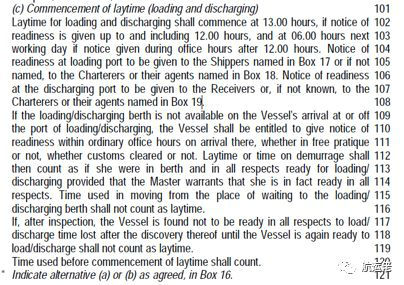
The vessel arrived at pilot station of loading port of Lubuk Gaung, Indonesia at 2120 hrs on Sep 19, 2018, sea pilot on board at 2128hrs and notice of readiness was tendered at that time. The vessel anchored at Dumai-Inner anchorage at 0100hrs on Sep 20; Harbour pilot on board and commenced shifting at 0800hrs on Sep 23, made all fast at 0930hrs, commenced loading at 1445hrs on same day and completed her loading at 1245hrs on Sep 30, 2018 with total cargo of palm kernel expeller 6,300mts in bulk. The vessel then sailed for her destination.
The vessel arrived at the 1st discharge port of Lianyungang anchorage at 1600hrs on Oct 16, 2018 and notice of readiness was tendered at that time. The vessel proceeded to berth #12 and Pilot on board at 2025hrs, made all fast at 2154hrs on the same day. Discharge of cargo commenced at 0040hrs on Oct 17, and completed her discharging at 2110hrs on Oct 18, 2018, then sailed for her 2nd discharge port.
The vessel arrived at the 2nd discharge port of Ying Kou at 0355hrs on Oct. 23 2018 and notice of readiness was tendered at that time. She was in fact ready to discharge. Due to port congestion and weather condition, The vessel delayed her berthing schedule and anchor aweigh for shifting on Oct 30 at 1608hrs, made all fast at 1800hrs, discharge of cargo commenced at 2125hrs on that day and completed her discharging at 2300hrs on Oct 31, 2018.
No disputes for laytime calculations at load port and 1st discharge port Lianyungang, but for 2nd discharge port Ying Kou, The owners claimed that laytime commence at 0800 hours on Oct 23 at Ying kou, i.e commence to run when notice of readiness was permitted to be given in accordance with provision 15 b.; Owners further contended that discharging operation was not suspended at berth, time lost during waiting for berth should count as laytime.
The charterers denied liability and contended that the notice of readiness was invalid and of no effect, having been "tendered" outside the period specified in cl. 15 a, between 0800 and 1700; And further that under berth charter, the risk of delay due to adverse weather should fall on owners, notice of readiness which tendered at anchorage was invalid, owners was not protected by wibon provision, laytime never commence until berthed. In each case, charterers they submitted, laytime commenced no earlier than when the discharging operation began.
The charterers therefore claimed that (a) Notice of readiness tendered outside hours stipulated by charter;(b) Under berth charter, notice of readiness was not entitled at anchorage if the berth was vacant, the risk of delay due to bad weather should fall on owners; (c) notice of readiness was nullities, laytime only commence when the vessel berthed.
A dispute arose between the parties, the issue being whether the charter required notice of readiness to be tendered within particular hours of the day so that if the notice was tendered outside those hours, even though the vessel was physically ready to load or discharge, it was an invalid notice and a nullity and a fresh notice had to be given inside those hours for laytime to begin; or whether the notice took effect when those hours began so that laytime began then. And further is that under berth charter, whether the Master was entitled to tender notice of readiness when arrival at anchorage, or only could be tendered when got alongside the berth; whether owners was protected by wibon provision and laytime could commence accordingly.
It is common ground (1) that when the notice of readiness was given the vessel had arrived at the appropriate place within the port in question and was in fact ready to discharge as required by the charter-party. The statement of readiness contained in each notice was in fact correct when it was made; (2) that the vessel's state of readiness continued thereafter; and (3) that no further notices were given.
The SOF of Ying Kou as below:
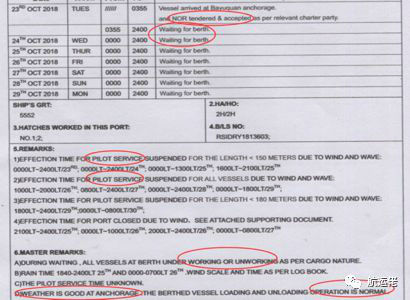
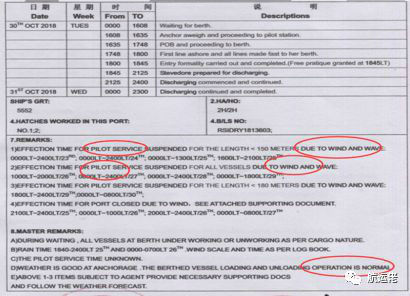
On the authority of The “Petr Schmidt” [1998] 2 Lloyds’ Rep. 1 (C.A.) case, The charterers no more required notice of readiness to be tendered within particular hours of the day so that if the notice was tendered outside those hours. Much of the argument still in issue has revolved round the difference between two kinds of voyage charter-party, a port charter-party on the one hand and a berth charter-party on the other. Owners contended the charter is port charter and the charterers contended it’ is berth charter. And the charterers further contended that time loss due to pilot service not available (because of bad weather) at Bayuquan not to count as we fixed “WEATHER WORKING DAY”, thus those period not to count as laytime.
The owners replied below and claimed that those period, as charterers alleged pilot services suspended still should be weather working day.
Thanks for charterers’ last, but Owners could not accept charterers’ allegation that time loss due to pilot service not available (because of bad weather) at Bayuquan not to count as we fixed “WEATHER WORKING DAY”.
In respect of “WEATHER WORKING DAY”, It’s well settled in Compania Naviera Azuero SA v British Oil & Cake Mills Ltd and others [1957] 1 Lloyd’s Rep 312, Where Justice Pearson said at page 329:
In my view, a correct definition of a “weather working day” is a day on which the weather permits the relevant work to be done, whether or not any person avails himself of that permission; in other words, so far as the weather is concerned, it is a working day.
In my view, also, the converse proposition must be on the same basis. A day is not a weather working day, it fails to be a weather working day, in so far as the weather on that day does not permit the relevant work to be done, and it is not material to inquire whether any person has intended or planned or prepared to do any relevant work on that day. The status of a day as being a weather working day, wholly or in part or not at all, is determined solely by its own weather, and not by extraneous factors, such as the actions, intentions and plans of any person.
His observation which was upheld in House of Lord case, Reardon Smith Line Ltd v Ministry of Agriculture, Fisheries and Food [1963] 1 Lloyd’s Rep 12. In this case, Where Lord Justice Devlin said at page 41:
It is well established that whether a day is a weather working day or not depends on the character of the day and not on whether work was actually interfered with. The authorities on this point have recently been reviewed by Mr. Justice Pearson in Compania Naviera Azuero S.A. v. British Oil & Cake Mills, Ltd., and Others, [1957] 2 Q.B. 293; [1957] 1 Lloyd's Rep. 312, and neither side challenged the correctness of his decision.
Trust the charterers have no objection that we must be bound by above authorities, As a matter of law which was not challenged.
Now let us review the SOF, As charterers alleged that time loss due to pilot service not available, but it’s clear that discharge operation was not affected at berth, still discharge in normal. The weather is suitable for our vessel to discharge this kind of cargo. Thus it’s a WEATHER WORKING DAY basis above mention authorities.
Meanwhile, In order to apply those principles of laytime calculation which were stipulated in《Laytime and Demurrage》Chapter 1-General Principles,2.85, the following questions must first therefore be answered:
- Did the weather interruption occur on a working day?
- What were the relevant hours of work?
- Did the interruption occur in working hours?
- What is the proportion that the interruption bore to the total daily hours of work?
- What is that fraction applied to 24 hours expressed in hours andminutes?
Hope above are clear and will be acceptable by the charterers.
Upon safe receipt above message, The charterers turn to their 2nd argument, contended that the charter was berth charter, a notice of readiness can be given if the port is congested and the berth is unavailable. And send below:
Refer to owners below reply dd 23 Nov, we had study some cases and would like to comments asf:
Firstly, our load and dischg term fixed under WWWW (wibon, wccon, wifpon, wipon) and LDG/ DEHG 1/2 SB/A(2) EACH 1SP
In The’Kyzikos’ (1989) 1 LLR 1 that ‘Whether in berth or not (WIBON)’ effectively means ‘whether in berth (a berth being available) or not in berth (a berth not being available)’
The phrase is relevant in “berth charters” to indicate that a Notice of Readiness can be given if the port is congested and the berth is unavailable because of this congestion.
And In Donald Davies’s book, 4th edition, page 62 said:
‘The short result of the House of Lords’ decision is that the ‘ Wibon’ clause only applies to cases where a berth is not available and does not apply to case where a berth is available for the vessel but unreachable because of weather/navigation factors.’
I had studied a case as attached and the final Arbitration of the arbitral tribunal asf:
Berth Charter: with regard to commencement of laytime, there are several conflicting clauses/evens. However, the starting point, I suggest, is that the parties negotiated and agreed a berth charter (Box 10). Thus the vessel had no reach the loading berth before a valid notice of readiness can be tendered. If the berth is congested on the vessel’s arrival off the port, the owners are protected by the WIBON, WIFPON, WIPON, WICON provisions in Clause 23. Laytime can then commence in accordance with the provisions of Clause 23, just as if the vessel was alongside the loading berth.
If the berth is inaccessible because of bad weather or whatever (absent of force majeure event/navigation factors) then the owner have to lump it and wait at their time and expense until the impediment is removed- just as if they had encountered an interruption on the way to Karwar (lport name for the case) – perphaps 1,000 miles distant. We are told that the ‘Karwar Port Tug was out of order from 10/02/05 to 14/02/05 till 1100hrs’.
There is no evidence of or any suggestion that the berth was congested and the pilot boarded the vessel at 1720hrs 14 Feb – shortly after the tug was repaired.
Simply the vessel could not reach the berth because there was no tug assistance. That is an owner’s risk and any notice of readiness tendered from the anchorage is those circumstances was, on the face of it, invalid.
For our case, the vsl arrived on 23 Oct and have free/available berth but unreachable due to pilot service not available under sea swell and strong wind fm 23-30 Oct 2018.
In this case, according to The ‘Kyzikos’, WIBON should not assist the owners. It would not be able to ‘advance’ the tendering of NOR. Accordingly, the NOR tendered at hrs on 23 Oct 2018 should be invalid.
Laytime counting only during 25-27 Oct while berth was occupied by Fu Long.
Secondly, PKE is powder condition type cargo, to avoid cargo qty loss due to wind blow and air pollution during cargo loadg/dischg, stevedore/port had right to stop the cgo loadg/dischg during strong wind over 5knots which agent been informed all concern parties also both port had environmental inspection
In view of above charterers’ view and comments, we would like to insist our last calculation and waiting for owners confirm to close the file, tks.
The owners denied the charterers’ submittion. In respect the characteristics of port charter or berth charter, it’s well settled in The “Kyzikos” [1989] 1 Lloyd’s Rep.1 (H.L.) , Where Lord Brandon said at p4:
The characteristics of a port charter-party are these. First, the contractual destination of the chartered ship is a named port. Secondly, the ship, in order to qualify as having arrived at the port, and therefore entitled to give notice of readiness to discharge, must satisfy two conditions. The first condition is that, if she cannot immediately proceed to a berth, she has reached a position within the port where waiting ships usually lie. The second condition is that she is at the immediate and effective disposition of the charterers. By contrast, the characteristics of a berth charter-party are these. First, the contractual destination of the chartered ship is a berth designated by the charterers within a named port. Secondly, the ship, in order to qualify as an arrived ship, and therefore entitled to give notice of readiness to discharge, must (unless the charter-party otherwise provides) have reached the berth and be ready to begin discharging.
During enroute, The charterers ever sent below discharge port declaration, declare that DISCHARGE PORTS ARE LIANYUNGANG & YING KOU, which is clear that contractual destination of the chartered ship is a named port.
Re: MV U CP DD 07 Sep 2018 - Disport declaration+Agent details
++Qte++
Good day,
Disch ports are Lianyungang 3k & Yingkou (Bayuquan) 3.3k
LYG agent:
XXX
+++
YK agent:
+++
XXX
+++
The owners maintained this charter was port charter and reply below:
Thanks for charterers’ last comments, but regret that Owners could not accept charterers’ allegation.
For charterers’ easy reference, Owners would draw charterers’ keen attention to below Owners’ comments:
1、Port Charter
Charterers rely on The “Kyzikos” case, but in that case, As Lord Brandon of Oakbrook observed:
First, the contractual destination of the chartered ship is a named port.
Secondly, the ship, in order to qualify as having arrived at the port, and therefore entitled to give notice of readiness to discharge, must satisfy two conditions.
The first condition is that, if she cannot immediately proceed to a berth, she has reached a position within the port where waiting ships usually lie. The second condition is that she is at the immediate and effective disposition of the charterers.
By contrast, the characteristics of a berth charterparty are these.
First, the contractual destination of the chartered ship is a berth designated by the charterers within a named port.
Secondly, the ship, in order to qualify as an arrived ship, and therefore entitled to give notice of readiness to discharge, must (unless the charterparty otherwise provides) have reached the berth and be ready to begin discharging.
Owners could put in italics and highlighted, if as the charterers contend that this charter is berth charter, the contractual destination must be a berth. But refer to below message which was from the charterers, It’s no any disputed that destination of the vessel are named port, i.e Lianyungang and Yingkou respectively. On decision of The “Kyzikos” case, this charter should be port charter.
///
Re: MV Unirich/Raffles CP DD 07 Sep 2018 - Disport declaration+Agent details
++Qte++
Good day,
Disch ports are Lianyungang 3k & Yingkou (Bayuquan) 3.3k
LYG agent:
+++
MR ZHAO
Sinomaritime Shipping Agency(Lianyungang) Co., Ltd.
Email: smt@sinomaritimelyg.com
+++
YK agent:
+++
MS TRACY CHI
Ulan shipping agency yingkou co.ltd
///
Charterers may refer to Freight Connect (S) Pte Ltd v Paragon Shipping Pte Ltd [2015]SGCA 37 case, In this case, The MV “AAL Dampier” arrived Nanwei port on 20th/Aug 2012, and tendered NOR at 2115hrs. And berthed o/a 27-28/Aug, Owners claim detention.
The charter provides:
02) LOADING PORT: 1SBP OWNERS BERTH NANWEI PORT, GUANGDONG, PR CHINA.
...
04) LAYCAN: 10TH - 20TH, AUG, 2012
Clause 19 of the first fixture incorporated the terms of a standard form contract codenamed "Gencon".
VESSEL:
- AAL tonnage or sub ( intention AAL DAMPIER)
...
PORTS OF LOADING & DISCHARGE:
- POL: Nanwei Port
- POD: Singapore
TIME OF SHIPMENT:
- 19 - 20.08.2012
FREIGHT & TERMS:
- USD 161,000.00 Lumpsum
- Freight based on Hook / Hook
- Detention USD 25,000.00 per day pro rata
GENERAL CONDITIONS:
- Carrier's Berth and Agents at all ends
And Chan Sek Keong SJ in arriving at the finding that the second fixture was a port charterparty, had referred to the email which "lists the ports of loading and discharge as Nanwei and Singapore respectively" [emphasis in original]. In the court their view, The Judge had applied the correct legal principles as enunciated by Lord Brandon of Oakbrook in The Kyzikos to hold that the second fixture was a port charterparty.
Thus the charteres contended this charter was berth charter was groundless, actual should be port charter. The Master was entitiled to tender NOR at anchorage and all risks of delay will be on charterers.
2、WWWW
In respect of WWWW, It’s well established principles under English law, Owners will be protected. Such as London Arbitration 1/09, NOR could be tendered WIBON/WIPON/WCCON/WEPON, even though load place was “1 SBP Zhenjiang”, but Tribunal still held that it’s port charter and reject charterers’ submission. For this Charterers may refer to latest edition《Laytime and Demurrage》Chapter 3 Commencement of laytime 3.33, where provides:
3.33 In London Arbitration 1/09,32 the tribunal rejected the charterers’ submission that the charter in question was a berth charter in respect of the load port where it provided for the vessel to load at: 1 SBP Zhenjiang.
3、The construction of berth/port charter
In North River Freighters Ltd v President of India (The Radnor) case, Charterparty was Gencon form, and load place was described as :…one safe berth Dairen…and there load a full and complete cargo…
Lord Justice Parker held that No doubt where the charter is in the form 'That the vessel shall proceed to….' a named port 'and there load at one safe berth,' the charter is a port charter. The contractual voyage is to the port, albeit that the owners must obey the charterer's instructions as to the berth nominated by the latter. Here, however, the contractual voyage is not to the port of Dairen, and if necessary I would have held that this is a berth charter.
In Lord Justice Jenkins his view, Whereas in the case of a berth charter (that is to say, a charter which requires the vessel to proceed for loading to a particular berth either specified in the charter or by theexpress terms of the charter to be specified by the charterer) laydays do not begin to run until the vessel has arrived at the particular berth, is ready to load, and has given notice to the charterer in manner prescribed by the charter of her readiness to load.
But in our case, There are no any express terms of the charter to be specified by the charterers, Charterers’ declarations were PORTs. Thus our charter should be port charter.
Furthermore, In The “Finix ”[1975] case,Lord Justice Donaldson where observed that:It is well settled that where the destination is a named berth or there is an express right to nominate a berth, the charter is a berth charter-party, i.e., the ship is not 'arrived' before she reaches the berth. It is also well settled that where the destination is an area of wider extent, but there is an implied right in the charterer to nominate the berth or other discharging spot, the ship is 'arrived' when she reaches the appropriate part of the wider area and not when she later reaches the discharging berth or spot.
But there is a realm of uncertainty where the charter-party provides that discharge shall take place at, for example, (a) 'One safe berth, London' or (b) 'London, one safe berth'. The test is undoubtedly whether on the true construction of the charter-party, the destination is London or the berth.
My own view is that in case (a) it is the berth and in case (b) it is London. This point arose in The Radnor and Lords Justices Singleton and Parker seem to have inclined to this view.
And refer to 《Laytime and Demurrage 》3.5, which reads:
3.5 Where such a formula is used, the effect is as if the berths, docks or ports, as the case may be, which are subsequently nominated by the charterer, were written into the original fixture.
No any doubt that the charterers’ declaration were Lianyungang and Yingkou ports, not designed berths; Charterers never nominate special berths for the vessel.
Basis all reasons given above, Hope the charterers will accept that this charter is PORT CHARTER, and NOR which tendered at anchorage was valid.
But the charterers still no willing to accept the owners’ comments and reply below.
Further our explanation, we would like to highlight below two ponts again for short:
Firstly, refer to charter party clause 20: B & C
B: NOR at first or sole loadg and dischg port shall be given during normal office hours only. Office hours are deemed to be Monday to Friday 08:00-17:00hours, Satday 08:00-12:00hours WWWW
C: If, upon arrival at ports of loading or discharging, the berth is not available due to congestion, the Master may tender Notice of Readiness by cable or by radio to Charterers’ agents, whether in berth or not, whether in port or not, whether in free pratique or not, whether in custom clearance or not. Sailing/shifting time from anchorage or usual waiting place to loading or discharging berth not to count,unless vessel is on demurrage
That these observations applied only if port is congested and the berth in unavailable because of congestion. If a berth was available but the vsl was prevented fm proceeding to it by bad weather/tide condition. The long line of authority on the use of the phrase ‘WIBON’ dealt exclusively with the problem of congestion in ports, and not with bad weather/tide condition/navigation factors preventing the vsl fm proceeding to a vacant berth
In short, above agreed term should be interpreted as applying only to case where a berth is not available and not to cases where a berth is available but is unreachable by reason of bad weather/tide condition/ navigation factors.
Secondly, refer to Charter Party Clause 20: A: ‘weather working day of 24 consecutive hours’ “Strong wind also to be counted as non-weather working.”
Describes a type of working day. Its does not matter whether the vessel was actually working or not.
Therefore, that even if a ship is not actually on the loadg (or dischg) berth, if time has started to run and bad weather occurs during a working day, that time will not count against chatterers as laytime.
Conversely, where the charter party reads ‘working day of 24 consecutive hours’, then bad weather occurring at any time would be deducible even if the charterer had no intention of working during such a period.
So even the vsl still at anchorage but bad weather cause pilot service not available at byq shall not count.
Bss above cp agreed laytime term, the effection time for pilot service suspended due to wind and wave shall not to count even the vsl still at anchorage position.
Tks n Brgds
The owners denied the charterers’ argument and reply below:
Sorry for late reply, Owners fully agree with charterers’ last comments, but seem those were not assist for charterers’ case.
Refer to SOF at Ying Kou, which was showing the vessel was waiting for berth. Thus under WWWW clause, Owners are entitled to tender valid NOR at anchorage. If the charterers contended berth was vacant, then they must burden of proof to show that there are no any other vessel occupied the berth. Otherwise as showing in SOF, the natural construction which, in any event, should be put upon those words-waiting for berth, which must be construed that berth was occupied.
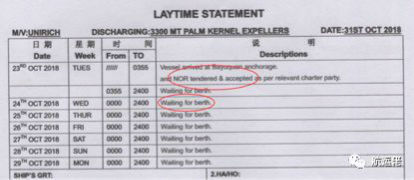
If the charterers may further contended that NOR was tendered outside office hours, but NOR still will be valid in next office hours, i.e 0800hrs. Charterers may refer to Galaxy Energy International Limited v Novorossiysk Shipping Company (The “Petr Schmidt”) [1998] 2 Lloyds’ Rep. 1 (C.A.) case, In that case the charter required that NOR be tendered within 0600 to 1700 hours local time. The Court of Appeal upheld owners' contention that a notice tendered out of hours took effect when those hours began.
On the other hand, It’s well settled that the contracts should be construed as a whole. For the laytime calculation, The charterers alleged could not commence which owners denied. The charterers please refer to provision of 15 b. which provides:
15 b. Laytime at 2nd load/discharge port (if any) to commence upon tendering of notice of readiness provided within normal office hours (as above), otherwise laytime shall count from next resumption of work or next working day 0800hrs Whichever is earlier.
It’s clear that at 2nd discharge port-Yingkou, laytime shall count from 0800hrs at the same day, i.e at 0800hrs on 23rd/Oct 2018, by that time laytime could commence.
Finally, if the charterers still no willing to accept above, Owners wish to draw charterers to pay their keen attention to SOF at Ying Kou, which is clear showing that: NOR TENDERED & ACCEPTED.., Charterers never required the Master to re-tender NOR, thus the charterers has waived their right.
For this, the charterers please refer to The “Happy Day” [2002] 2 Lloyd’s Rep. 487 ( C.A.), Where Potter LJ said at p510, as below:
In the context of this case I would answer the question of law in relation to which leave was granted as follows. Laytime can commence under a voyage charterparty requiring service of a notice of readiness when no valid notice of readiness has been served in circumstances where (a) a notice of readiness valid in form is served upon the charterers or receivers as required under the charterparty prior to the arrival of the vessel: (b) the vessel thereafter arrives and is, or is accepted to be, ready to discharge to the knowledge of the charterers; (c) discharge thereafter commences to the order of the charterers or receivers without either having given any intimation of rejection or reservation in respect of the notice of readiness previously served or any indication that further notice of readiness is required before laytime commences. In such circumstances, the charterers may be deemed to have waived reliance upon the invalidity of the original notice as from the time of commencement of discharge and laytime will commence in accordance with the regime provided for in the charterparty as if a valid notice of readiness had been served at that time. By answering the question in that way, I should not be thought to doubt that, in appropriate circumstances, the same result may follow by application of the doctrines of variation and estoppel.
On authority of The “Happy Day”, no any doubt that in our case, laytime will commence by then, i.e 0800hrs on 24th/Oct 2018.
As a matter of law, trust the charterers will accept that this was not challenged at all.
In respect of Charterers’ second argument, for weather working day. Refer to SOF, there is no showing discharging operation was suspended due to strong wind, Just pilot service was suspended. Owners thus maintain that those period still should be WEATHER WORKING DAY.
As Justice Pearson said in Compania Naviera Azuero SA v British Oil & Cake Mills Ltd and others [1957] 1 Lloyd’s Rep. 312 case at p329:
In my view, a correct definition of a “weather working day” is a day on which the weather permits the relevant work to be done, whether or not any person avails himself of that permission; in other words, so far as the weather is concerned, it is a working day.
In my view, also, the converse proposition must be on the same basis. A day is not a weather working day, it fails to be a weather working day, in so far as the weather on that day does not permit the relevant work to be done, and it is not material to inquire whether any person has intended or planned or prepared to do any relevant work on that day. The status of a day as being a weather working day, wholly or in part or not at all, is determined solely by its own weather, and not by extraneous factors, such as the actions, intentions and plans of any person.
Which was upheld in Reardon Smith Line Ltd v Ministry of Agriculture, Fisheries and Food [1963] 1 Lloyd’s Rep.12(H.L.) case, In this House of Lord case, Where Devlin LJ said at p41:
It is well established that whether a day is a weather working day or not depends on the character of the day and not on whether work was actually interfered with. The authorities on this point have recently been reviewed by Mr. Justice Pearson in Compania Naviera Azuero S.A. v. British Oil & Cake Mills, Ltd., and Others, [1957] 2 Q.B. 293; [1957] 1 Lloyd's Rep. 312, and neither side challenged the correctness of his decision.
During those period discharge operation at berth was normal, those period permit the relevant work, such in our case permit to discharging the cargo. Pilot service was suspended does not render those period was not WEATHER WORKING DAY.
Hope above are clear enough and will be acceptable by the charterers.
Owners are looking forward to receiving charterers’ positive confirmation by return.
On the contrary, I am of opinion, having regard to the authorities to which the owners referred earlier and the context in which the acronym WWWW, especially "wibon" is to be found in the charter-party here concerned, that the phrase "whether in berth or not" should be interpreted as applying only to cases where a berth is not available and not also to cases where a berth is available but is unreachable by reason of bad weather. The notice of readiness will be nullity if no any other provisions.
However, I can agree with the owners’ view that charterers' reliance on above mentioned provisions to reject the owners’ claim is misplaced. As the owners correctly pointed out that the charterers’ declarations were ports, not designed berth name. The owners have also correctly relied on those authority/decisions to strengthen their claim against the charterers.
With respect to all comments from the owners, I have to reach that conclusion on what the owners described as port charter and weather working day, which appear to me to have considerable force.
In my view, there is no conflict in this charter-party. As provision of 15 in clean recap which provides:
15-NOR/LAYTIME TO BE TENDERED WITHIN LAYCAN/COMM AS PER GENCON 94 C/P.
It plainly to be construed and read as: NOR to be tendered with laycan, laytime commence as per GENCON94. This should be applied at load port only. For discharging port, 15.6 where stipulated that:
b. Laytime at 2nd load/discharge port (if any) to commence upon tendering of notice of readiness provided within normal office hours (as above), otherwise laytime shall count from next resumption of work or next working day 0800hrs Whichever is earlier.
Laytime at 2nd discharge port to commence upon tendering of notice of readiness, if not within normal office hours, then laytime shall count from next resumption of word or next working days. There is therefore nothing in this clause, nor in the charter as whole which contra-indications that the charterers contend laytime could not commence, to my mind, is the plain and obvious meaning of the words used in the clause, given it’s true construction in this case the time will be 0800hrs on Oct 23, 2018 as the owners correctly pointed out. I am satisfied that the owners would be protected under this clause and the charterers’ estoppel, the charterers have waived their rights.
For all reasons given above I think the charterers must fail as to liability for the owners’ demurrage claim at Ying Kou.
附言:本文主要涉及在营口港laytime计算的争议问题,承租人包括其经纪人均认为租船合同中的 “1/2 SB/A(2) EACH 1SP RIZHAO, QINHUANGDAO, QINGDAO, BAYUQUAN (including yingkou), PANJIN, TAIZHOU, NANTONG, N.CHINA AT CHOPT.”构成了泊位租约合同,事实上并非如此。
此外,本文还涉及NOR递交,Laytime起算,Weather working day等的解释问题。如果想要避免争议,合同条款还需要更加清晰明确的措辞,但承租人并未做到这一点。
2018.12.06
海运圈聚焦专栏作者 Alex (微信公众号 航运佬)

 2018-12-24
2018-12-24 2736
2736 



